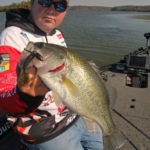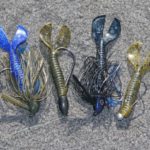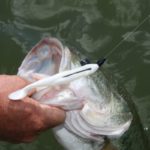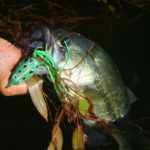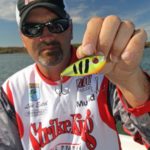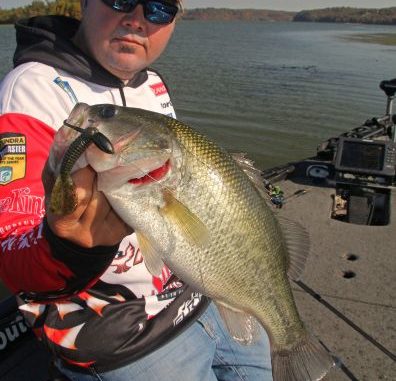
When bass lock down and refuse to bite, subtle changes can trigger strikes from testy bass. Here are some tips on how to round out your limit on these tough days.
You know they’re there, but the bass just have a bad attitude and they’re refusing to cooperate. Persistence is certainly an admirable trait, but repetitive casts are only one tactic for getting the job done.
Often, bass anglers have to dig a little deeper into their bag of tricks to find the right combination of elements that push a reluctant bass over the edge.
Consider that a bass is more than fins propelling a big mouth. These critters have eyes, ears and lateral lines for very specific reasons, and the combined package of sensory perception that the fish receives drives them to action or avoidance.
Savvy anglers will do well to take an open-minded approach to tempting their largemouth quarry. Here’s a handful of starting-point ideas. Look at your specific scenarios and adjust as needed.
Varied presentations
We all know the feeling of confidence that comes from finding a soft-plastic bait that just does it for you, but we also should know that what we like won’t always remain congruent with what the bass like. You’ll catch fish for a while and they’ll eventually peter off, but that’s no mandate for replacing that productive plastic.
You might just need to change up the way you serve it to Mr. Bass’ dinner table.
Bassmaster Elite Series pro Greg Hackney is a big fan of the Strike King Rage Twin Tail Menace Grub, and when bass are feeding around hydrilla edges, Hackney knows that flipping that bait on the back of his signature ¾-ounce Strike King Hack Attack jig can be just the thing to trigger that largemouth hostility with nothing more than a sudden, in-your-face intrusion.
“It’s a big, aggressive bait that falls fast through the cover and makes them react,” Hackney said. “You’ll get fewer bites on a jig, but it’s usually your bigger fish.”
Now, at times, Hackney might find that the fish aren’t down with the big jig, but he still believes in the alluring presentation of the Menace. That’s when he’ll change up his presentation to suit the situation.
Maybe the fish have buried deep in the weed mats. In this scenario, he’ll Texas rig the bait with a tungsten weight and punch it through to startle lounging bass.
Or maybe he’s searching scattered weeds to find interested prespawners, and a swim jig is the right escort for a Menace trailer.
And, of course, there’s always that finesse scenario – targeting bed fish, for example – where rigging his favored plastic on a light shaky head is the way to go.
Nose job
Soft-plastic swimbaits are a great search tool for covering water to find fish, but sometimes the bass might not feel like coming up to hit a bait running high in the water column. To extend the usefulness of this bait style, add a small bullet weight to the nose to make it swim deeper without the bulk of a weighted-shanked hook. This added nose density also helps your swimbait run through grass with less resistance and hang-ups.
Amphibious assault
Frogging over weeds is nothing new, but make sure you’re maximizing your opportunities. Consider that a bass has to A) listen very closely to detect a frog sliding across a 3-foot thick hydrilla mat and B) push pretty hard to blast through and capture this prey — all of this assuming good aim, of course.
Fact is, you’ll do much better by targeting points, dips and contour features of dense weeds, while keeping watch for those isolated holes or “windows” through which bass can spot and catch passing forage.
TIP: Along weed edges or within sparse vegetation, work your frog on a slack line with a low rod angle. This creates subtle side-to-side motion with minimal forward progress. Result: prolonged presentation in a tight area.
And here’s another switch-flipping tactic: Pull your frog onto either the edge of a lily pad, the perimeter of a window in the weeds or the actual edge of a weed bed, pause the bait with about half its body on the weeds and half hanging out over open water. Wiggle your bait ever so slightly to attract attention from below, and very often the water will erupt with carnivorous fury the moment you pull that frog off its perch.
Sounding off
It’s old school, but making a quiet bait not so quiet never loses its applicability. Whether it’s worm rattle inserts, jig rattle harnesses or rattle chambers stuffed through the legs of a hollow-body frog, making your bait sound like a pair of maracas is a sure bet for directing a bass’ attention in the right direction.
Taking this thought a step farther, think about those summer swims at the pool and remember how footsteps, clanking step ladders and your buddy’s cannonball dive sound when you’re under water. Sound waves are amplified by water, so things that go bump on rocks, laydowns, stumps and riprap are highly impactful on a bass’ awareness. Think squarebill crankbaits, football head jigs, Carolina rigs and Texas rigs. TIP: Tungsten weights increase the noise value of the latter two.
But at times you might need to silence a bait or switch to a similar model sans rattles. When FLW pro Phil Marks won a tournament on Sam Rayburn in Texas last fall, he caught most of his fish on the newly debuted Strike King 10XD, a jumbo crankbait that runs deep and makes a whole lot of commotion. He has since fared well with the bait’s silent version — still a deep presentation, but less-intrusive when the fish aren’t so aggressive.
Sometimes a silent version of the bait you want to use might not be available. In this case, a little lure surgery can make a big impact. The classic example involves silence through immobilization. Simply drill a small hole in the throat area of your noisy crankbait, squirt a little shot of two-part epoxy (Super Glue also works) inside and lean the bait forward so the knocker settles in the sticky stuff. You’ll want to clamp the lure in this forward leaning position for the prescribed set time. Once the epoxy or glue hardens, you have a silent version of the bait.
Size up the competition
Sometimes larger, sometimes smaller — that’s the truth about bass preference. Generally speaking, bass are more likely to bite large-profile baits during warmer weather and lower visibility, while cold water and high visibility usually requires a scaled-down presentation.
For example, while Hackney will flip his Hack Attack Jig in ¾- to 1-ounce sizes during much of the warm season and the fall feed-up, the cool, clear conditions of late winter through prespawn will find him switching to a diminutive ¼- or 3/8-ounce Strike King Bitsy Bug jig.
For Toledo Bend guide Stephen Johnston, going large has its time of relevance, as well. In stained water, low light or heavily pressured waters, he’ll bulk up his V&M Lightning Blade (chatterbait style) or swim jig with a bulky swimming tail like V&M’s Kickin Shad.
Similarly, swimming plastics like the Berkley Havoc Grass Pig or Reaction Innovations Skinny Dipper add bass-enticing character to the backside of a spinnerbait.
Conversely, there are times when slimming down your bait’s profile is the way to go. When Johnston fishes a Lightning Blade around grass but finds the fish less aggressive than he’d prefer, he knows that a long trailer can result in short strikes where the fish simply grab the tail and miss the hookup. Worse yet, a larger profile might simply be too much for the fish and may cause them to turn away from the big mouthful.
Johnston remedies this by removing his trailer and fishing the blade bare. The lighter rig means decreased casting distance, but it’s a good trade-off, as the smaller profile gets him the bites he needs.
Another thought on size applies to jig trailers and their affects on presentation. To the point, don’t think you have to fish that craw trailer as is. Bait manufacturers do their best to size their plastics for optimal effect, but sometimes, the first bite you need to consider is the one your teeth makes on that trailer’s bod.
A good example is stroking a football head jig. The key to this technique is a sharp rise and a quick fall, so a compact package is essential. A full size craw trailer often creates too much drag, so just bite off an inch or so of the body and tighten the package for the right presentation.
Colors and accents
There’s almost always something bass will eat, but we’ll save that discussion for another time. For the premise at hand, we’ll just point out the timeless wisdom of keeping dipping dies and/or dye markers handy. Very often, a good beaver or Brush Hog bite will eventually dwindle, but dye the tail sections chartreuse or maybe red, and you can expect the fish to regain their interest.
On the flipside, when dyeing dropshot baits, you might do better by dipping the head of the lure, as you want the fish to bite where the hook sits.
Another great color tip comes from Bassmaster legend Denny Brauer, who demands perfection from his jig presentation.
One of the most commonly overlooked preparation steps, he said, is jig skirt alignment. In a nutshell, jig production finds plenty of room for variance, and skirts are one of the most random assembly points. Brauer likes his skirt accents to line up evenly, so he’ll hold a jig by the hook and adjust the skirt so that accent color (blue strands in a black skirt) line up with the back of the jig. This, he said, maximizes the color’s impact, as opposed to having the accent color skewed to one side or the other.
Also, don’t underestimate the attraction of adding a subtle dose accent color to skirts. Weaving just a few strands of blue, orange or purple into an otherwise darker jig skirt can create a mighty convincing bluegill impersonation.
With regards to lure color patterns, it’s great if you or a buddy have mad air brush skills, but don’t feel left out if artistic ability isn’t your strong suit. Sometimes, the simplest and most rudimentary of markings made with a permanent marker can prove effective in attracting a little extra attention.
Red is the hot-button color that’s kind of hit-or-miss. Some feel very strongly that lures with red accents mimic wounded baitfish and therefore represent easy targets for bass. This strategy definitely has its moments, but don’t overlook your less vivid colors — black, brown, maybe even a green or blue.
Try dressing up your lipless crankbaits with vertical or diagonal stripes, or add a smattering of spots to the lower sides of your topwater frog. Realistic is certainly good, but don’t hesitate to try something eye-catching. You never know what a bass might find interesting and sometimes the oddball is the one they’ll attack.
Other enhancements that can flip the switch on bass aggression include feathered treble hooks that pulse in lifelike form behind jerkbaits and topwaters, along with colored beads (blue, red, gold) ahead of your Texas-rigged plastics or buzz toads.
Options are many, and personal creativity is your only limitation. You don’t have to accept the notion that the fish aren’t biting — you just have to locate their switch and flip it.
